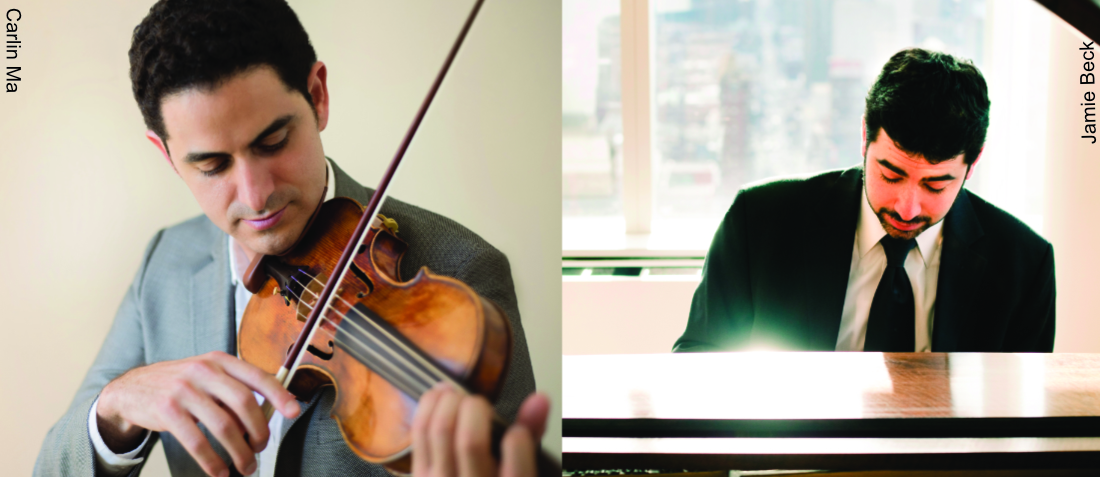2009 Avery Fisher Career Grant violinist, Arnaud Sussmann has distinguished himself with his unique sound, bravura, and profound musicianship, capturing the attention of classical critics and audiences around the world. Minnesota’s Pioneer Press writes, “Sussmann’s tone [is] a thing of awe-inspiring beauty, his phrasing spellbinding.”
Performing for us for the third time, pianist Michael Stephen Brown is “one of the leading figures in the current renaissance of performer-composers,” (The New York Times).
Their program for us, Jewish Voices, showcases works by Jewish composers who were impacted by the Holocaust. This is Sussmann and Brown’s first time performing together in our series.
Drawing inspiration from Arnaud Sussmann’s own grandfather’s survival of Auschwitz-Birkenau, Sussmann and pianist Michael Stephen Brown will perform works by Jewish composers whose lives were directly impacted by the war.
Erwin Schulhoff (1894–1942)
Suite for Violin and Piano, Op. 1 (1911)
Präludium: Stürmisch
Gavotte: Mäßig
Menuetto
Walzer
Scherzo: Schnell
Robert Dauber (1922–1945)
Serenade (1942)
Pavel Haas (1899–1944)
Suite for Oboe and Piano, Op. 17 (arr. for Violin and Piano) (1939)
Furioso
Con fuoco
Moderato
Samuel Adler (b. 1928)
Lullaby (based on an old Hebrew folk tune) (1984)
Mieczyslaw Weinberg (1919–1996)
Rhapsody on Moldavian Themes, Op. 47 (1949)
**Violinist Arnaud Sussmann appears by arrangement with
Dinin Arts Management & Consulting**
Program subject to change.
Program Notes
Suite for Violin and Piano, Op. 1 Erwin Schulhoff (1894–1942)
I. Präludium: Stürmisch
II. Gavotte: Mäßig
III. Menuetto
IV. Walzer
V. Scherzo: Schnell
Erwin Schulhoff was a Czech-born composer of German descent. By the age of three he could pick out melodies that he heard on the piano. Antonín Dvořák usually did not pay much attention to child prodigies, but after meeting Schulhoff and testing his ability to identify harmonies by ear, the composer gifted the young boy two pieces of chocolate and recommended that he study piano privately at the Prague Conservatory. Schulhoff went on to study theory and composition with Max Reger in Leipzig. Much of his early work was influenced by Richard Strauss and Claude Debussy. During the Second World War, Schulhoff was deported to the Theresienstadt concentration camp, where he died in 1942.
This suite for violin and piano is the composer’s first published work. The structure is influenced by early Baroque suites, which were collections of stylized courtly dances from around Europe. The Präludium is stormy, dramatic, and full of grand gestures that are shared between the violin and the piano. The Gavotte is more light-hearted, elegant, and restrained, where the Menuetto is intimate and highly expressive. Only during a minuet were courtly dancers allowed to briefly touch one another’s hands; a moment filled with romantic tension. Schulhoff’s Walzer is more daring with its use in complex harmonies than the waltzes of Johann Strauss. The final movement is the only one not modeled after a dance. The music is also the most free, full of chromatic acrobatics and subtle orchestration.
Serenade Robert Dauber (1922–1945)
Robert Dauber was born in Vienna and was the son of Dol Dauber, a famous violinist from Bukovina, a region in the Northern Carpathian Mountains. Dauber’s entire family moved to Prague in 1936 where he became an active cellist, pianist, and composer. He performed as a cellist in the opera Brundíbar, a children’s opera by the Czech composer Hans Krása. In 1942, Dauber was sent to Theresienstadt, then transferred to Dachau where he died in 1945. Brundíbar was performed by the children in the Theresienstadt camp. The title comes from a colloquial Czech word for bumblebee.
This composition is the only surviving work of Dauber’s. The passionate melody in the violin is draped in lush, sonorous harmonies in the piano. He contrasts free, swirling rhythms with more precise, short gestures. The piece ends with a haunting, chromatic flourish, before resolving to a sweet unison between both instruments. This tender love song is a brief but moving fragment of this young composer’s creative efforts.
Suite for Oboe and Piano, Op. 17 Pavel Haas (1899–1944)
I. Furioso
II. Con fuoco
III. Moderato
Pavel Haas was a Czech composer who studied for two years in the master classes of Leoš Janáček. His music combines elements of folk music, jazz, and other experimental harmonic practices. Haas was a prolific composer particularly well known for his string quartets, symphonic music, and choral works. He also composed for cinema and theater. He was deported to the Theresienstadt camp in 1941, where he performed in a production of Brundíbar alongside Robert Dauber and other Jewish musicians. The camp comandante arranged this performance and captured it in a propaganda film that was produced prior to an inspection from the Red Cross.
The suite is organized into three movements. The first two are to be played furiously or “with fire,” while the final movement is gentler and more reserved. Haas uses a harmonic language that embraces tense dissonances such that even the slow movement maintains an uneasy character throughout. The orchestration between the two instruments is carefully balanced, giving each performer the opportunity to demonstrate their technical and expressive abilities.
Lullaby Samuel Adler (b. 1928)
Samuel Adler was born in Mannheim Germany. His father was a cantor and a composer, and his mother was an amateur pianist. When he was just ten years old, he was separated from his father during the Kristallnacht pogrom in 1938. When the family was finally reunited, they fled to the Netherlands where they booked passage to the United States. In America, Adler would go on to attend Boston University and Harvard University, studying composition with Aaron Copeland, Paul Hindemith, and Randall Thompson. In 1950 he joined the U.S. Army where he served as a corporal in the 2nd Armored Division. He founded the Seventh Army Symphony Orchestra while he was stationed in Stuttgart, Germany. Since leaving the Army, Adler has served on the composition faculties at the Juilliard School and the Eastman School of Music. His orchestration textbook is still a staple of many undergraduate and graduate courses in music.
Before his illustrious career in music academia, Adler was a cantor at the Temple Emanuel in Worcester, Massachusetts. Like his father before him, he steeped himself in sacred and secular Jewish music. This tender lullaby is an homage to his heritage. Though Adler is often described as a modernist, as he uses free atonality and improvisation in his music, this piece demonstrates his deep understanding of the musical traditions that came before him.
Rhapsody on Moldavian Themes, Op. 47 Mieczysław Weinberg (1919–1996)
Mieczysław Weinberg was born in Warsaw where his father was an active conductor and composer of Yiddish theater music. At the age of twelve, Weinburg began studying at the Warsaw Conservatory where he graduated in 1939. After his schooling he settled in Minsk, but when Germany invaded the Soviet Union in 1941 he fled to the Uzbek Soviet Socialist Republic. It was here that Weinberg met the famous Russian composer Dmitri Shostakovich. The two became close friends, and Shostakovich urged him to move to Moscow to continue his compositional efforts. Weinberg composed at a feverish pace in Moscow but was arrested on suspicion of “Jewish bourgeoise nationalism” at the order of Joseph Stalin. Shostakovich advocated for Weinberg’s release and promised to care for his daughter while he was imprisoned. After Stalin’s death he was finally released.
The Soviet government often encouraged composers to include folk melodies from the various regions in the country. This strategy encouraged national unity, and ostensibly rejected decadent, bourgeoise modernism. Weinberg decided to focus on Moldavian music, as that is where both of his parents were born. This area of the world shares a lot of linguistic and cultural norms with Romania, but the final bombastic section of this piece is clearly inspired by Jewish klezmer music. The hurried melody in the violin evokes a fiery traditional dance. This piece was originally composed for orchestra.
Arnaud Sussmann, violinist
Winner of a 2009 Avery Fisher Career Grant, Arnaud Sussmann has distinguished himself with his unique sound, bravura and profound musicianship. Minnesota’s Pioneer Press writes, “Sussmann has an old-school sound reminiscent of what you’ll hear on vintage recordings by Jascha Heifetz or Fritz Kreisler, a rare combination of sweet and smooth that can hypnotize a listener. His clear tone [is] a thing of awe-inspiring beauty, his phrasing spellbinding.”
A thrilling young musician capturing the attention of classical critics and audiences around the world, Sussmann has appeared with major orchestras including the American Symphony, Buffalo Philharmonic, New World Symphony, Pacific Symphony, Paris Chamber Orchestra, Jerusalem Symphony, and the Vancouver Symphony. Further solo appearances in recent seasons included a tour of Israel and concerts at Lincoln Center’s Alice Tully Hall, Dresden Music Festival in Germany and at the Phillips Collection in Washington, D.C. Sussmann has been presented in recital at notable national series in Boston, Denver, New Orleans, Omaha, and Palm Beach, as well as in Tel Aviv at the Museum of Art and at the Louvre Museum in Paris. He has also given concerts at the OK Mozart, Chamber Music Northwest and Moritzburg festivals and appears regularly at the Beare’s Premiere, Caramoor, Music@Menlo, La Jolla SummerFest, Seattle Chamber Music, Moab Music, and Saratoga Springs Chamber Music festivals.
Recent concerto appearances include performances with Maestro Valery Gergiev and the Mariinsky Orchestra at the White Nights Festival in St Petersburg, the Alabama Symphony, Albany Symphony, Grand Rapids Symphony, Jacksonville Symphony, and Santa Rosa Symphony. Over the past two seasons, chamber music performances included tours with Music@Menlo to Florence, Italy and with the Chamber Music Society of Lincoln Center to Colombia’s Teatro Mayor, Korea’s LG Arts Center, Shanghai’s Oriental Center, and Hong Kong’s Music Academy.
Sussmann has performed with many of today’s leading artists including Itzhak Perlman, Menahem Pressler, Gary Hoffman, Shmuel Ashkenazi, Wu Han, David Finckel, Jan Vogler, and members of the Emerson String Quartet. He has worked with conductors such as Cristian Macelaru, Gemma New, Marcelo Lehninger, Rune Bergmann, and Leon Botstein. A dedicated chamber musician, he has been a member of the Chamber Music Society of Lincoln Center since 2006 and has regularly appeared with them in New York and on tour, including a recent concert at London’s Wigmore Hall.
A frequent recording artist, Sussmann has released albums on Deutsche Grammophon’s DG Concert Series, Naxos, Albany Records and CMS Studio Recordings labels. His solo debut disc, featuring three Brahms Violin Sonatas with pianist Orion Weiss, was released in December 2014 on the Telos Music Label, and his most recent feature recording featuring works by Beethoven, Bloch, Fauré, and Mendelssohn was released in 2019 on the Music@Menlo LIVE label. He has been featured on multiple PBS’ Live from Lincoln Center broadcasts alongside Itzhak Perlman and the Perlman Music Program and with musicians of the Chamber Music Society of Lincoln Center.
Born in Strasbourg, France and based now in New York City, Sussmann trained at the Conservatoire de Paris and the Juilliard School with Boris Garlitsky and Itzhak Perlman. Winner of several international competitions, including the Andrea Postacchini of Italy and Vatelot/Rampal of France, he was named a Starling Fellow in 2006, an honor which allowed him to be Mr. Perlman’s teaching assistant for two years. Sussmann currently teaches at Stony Brook University on Long Island and was recently named Co-Artistic Director of Music@Menlo’s International Music Program and Artistic Director of the Chamber Music Society of Palm Beach.
Michael Stephen Brown, piano
Michael Stephen Brown has been hailed by The New York Times as “one of the leading figures in the current renaissance of performer-composers.” His artistry is shaped by his creative voice as a pianist and composer, praised for his “fearless performances” (The New York Times) and “exceptionally beautiful” compositions (The Washington Post).
Winner of the 2018 Emerging Artist Award from Lincoln Center and a 2015 Avery Fisher Career Grant, Brown has performed as soloist with the Seattle Symphony, the National Philharmonic, and the Grand Rapids, North Carolina, Wichita, New Haven, and Albany Symphonies; and recitals at Carnegie Hall, the Mostly Mozart Festival, and Lincoln Center.
Brown is an artist of the Chamber Music Society of Lincoln Center, performing frequently at Alice Tully Hall and on tour. In 2022, he opened the Society’s season with Bach and Mendelssohn concertos and made European debuts as soloist with the NFM Leopoldinum Orchestra and performed recitals at the Beethoven-Haus Bonn and the Chopin Museum in Majorca. He was selected by András Schiff to perform on an international tour making solo debuts in Berlin, Milan, Florence, Zurich’s Tonhalle and New York’s 92nd Street Y. He regularly performs recitals with his longtime duo partner, cellist Nicholas Canellakis, and has appeared at numerous festivals including Tanglewood, Marlboro, Music@Menlo, Gilmore, Ravinia, Saratoga, Bridgehampton, Caramoor, Music in the Vineyards, Bard, Sedona, Moab, and Tippet Rise.
As a composer, he recently toured his own Concerto for Piano and Strings (2020) around the US and Poland with several orchestras. He was the Composer and Artist-in-Residence at the New Haven Symphony for the 2017–2019 seasons and a 2018 Copland House Residency Award recipient. He has received commissions from the Gilmore Piano Festival, the NFM Leopoldinum Orchestra; the New Haven and Maryland Symphony Orchestras; Concert Artists Guild, Shriver Hall; Osmo Vänskä and Erin Keefe; pianists Jerome Lowenthal, Ursula Oppens, Orion Weiss, Adam Golka, and Roman Rabinovich; and a consortium of gardens.
A prolific recording artist, his latest album, Noctuelles, featuring Ravel’s Miroirs and newly discovered movements by Medtner was called “a glowing presentation” by BBC Music Magazine. He can be heard as soloist with the Seattle Symphony and Ludovic Morlot in the music of Messiaen, and as soloist with the Brandenburg State Symphony in music by Samuel Adler. Other albums include Beethoven’s Eroica Variations; all-George Perle; and collaborative albums each with pianist Jerome Lowenthal, cellist Nicholas Canellakis, and violinist Elena Urioste. He is now embarking on a multi-year project to record the complete piano music by Felix Mendelssohn including world premiere recordings of music by one of Mendelssohn’s muses, Delphine von Schauroth.
Brown was First Prize winner of the Concert Artists Guild Competition, a winner of the Bowers Residency from the Chamber Music Society of Lincoln Center (formerly CMS Two), a recipient of the Juilliard Petschek Award, and is a Steinway Artist. He earned dual bachelor’s and master’s degrees in piano and composition from The Juilliard School, where he studied with pianists Jerome Lowenthal and Robert McDonald and composer Samuel Adler. Additional mentors have included András Schiff and Richard Goode as well as his early teachers, Herbert Rothgarber and Adam Kent.




